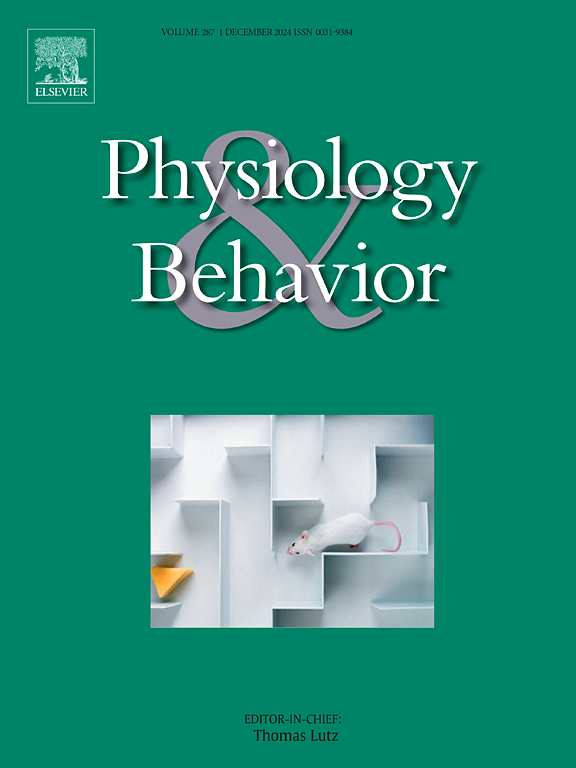LEAP2:从喂养调节到饮食失调的影响。
IF 2.5
3区 医学
Q2 BEHAVIORAL SCIENCES
引用次数: 0
摘要
在胃促生长素(ghrelin)发现近20年后,一种在胃中合成并作用于其同源受体GHSR的强效生长激素促生长素(GHS)和促氧肽(oreigenic peptide) LEAP2 (Liver Expressed Antimicrobial peptide 2)被确定为内源性ghrelin拮抗剂,主要产生于肝脏和小肠。本文综述了LEAP2作为抗菌肽的初步特征及其在对抗胃饥饿素对食物摄入、生长激素分泌、享乐进食和能量稳态的作用中的作用。我们还描述了ghrelin和LEAP2的长期调节受正能量和负能量平衡的影响,短期调节受膳食和营养摄入的影响。然后,我们讨论了LEAP2变异对LEAP2浓度和功能的影响,以及它们与改变饮食行为的可能关联。最后,作者还强调了LEAP2在与异常摄食行为(如神经性厌食症)相关的病理中的潜在意义。由于ghrelin和LEAP2对食物摄入、能量稳态、葡萄糖稳态、享乐性喂养和奖励的作用相反,它们是影响能量稳态和饮食失调的关键药理靶点。这些发现为理解在生理和病理条件下由GHSR传递的调节饮食行为和更广泛的能量平衡的机制开辟了新的视角。本文章由计算机程序翻译,如有差异,请以英文原文为准。
LEAP2: from feeding regulation to its implications in eating disorders
Almost twenty years after the discovery of ghrelin, a potent Growth Hormone Secretagogue (GHS) and orexigenic peptide synthesized in the stomach and acting on its cognate receptor, the GHSR, LEAP2 (Liver-Expressed Antimicrobial Peptide 2), produced mainly in the liver and small intestine, was identified as an endogenous ghrelin antagonist. This article reviews the initial characterization of LEAP2 as an antimicrobial peptide and its role in opposing ghrelin’s actions on food intake, GH secretion, hedonic feeding and energy homeostasis. We also describe the long-term regulation of ghrelin and LEAP2 by positive and negative energy balance, and their short-term regulation by meals and nutrient intake. We then discuss the effect of LEAP2 variants on the concentration and function of LEAP2 and their possible associations with altered eating behaviors. Finally, the potential implications of LEAP2 in obesity or pathologies associated with abnormal feeding behavior such as anorexia nervosa are also highlighted. Due to their opposite actions on food intake, energy homeostasis, glucose homeostasis, hedonic feeding and reward, ghrelin and LEAP2 represent key pharmacological targets for disorders impacting energy homeostasis and eating. These discoveries open up new perspectives for the understanding of the mechanisms that regulate eating behaviors and more broadly energy balance, relayed by the GHSR, in physiological and pathological conditions.
求助全文
通过发布文献求助,成功后即可免费获取论文全文。
去求助
来源期刊

Physiology & Behavior
医学-行为科学
CiteScore
5.70
自引率
3.40%
发文量
274
审稿时长
47 days
期刊介绍:
Physiology & Behavior is aimed at the causal physiological mechanisms of behavior and its modulation by environmental factors. The journal invites original reports in the broad area of behavioral and cognitive neuroscience, in which at least one variable is physiological and the primary emphasis and theoretical context are behavioral. The range of subjects includes behavioral neuroendocrinology, psychoneuroimmunology, learning and memory, ingestion, social behavior, and studies related to the mechanisms of psychopathology. Contemporary reviews and theoretical articles are welcomed and the Editors invite such proposals from interested authors.
 求助内容:
求助内容: 应助结果提醒方式:
应助结果提醒方式:


